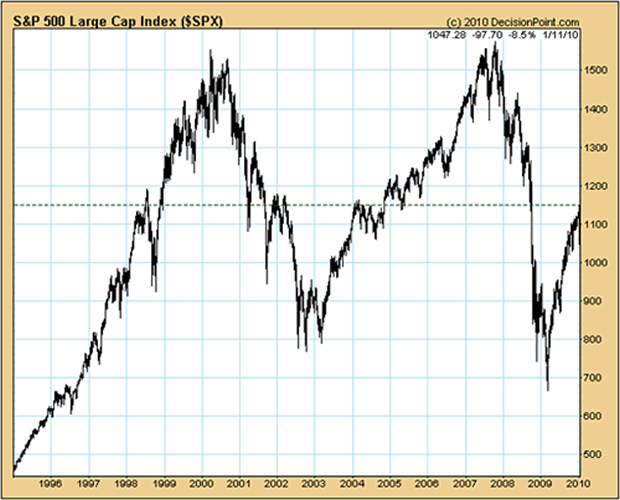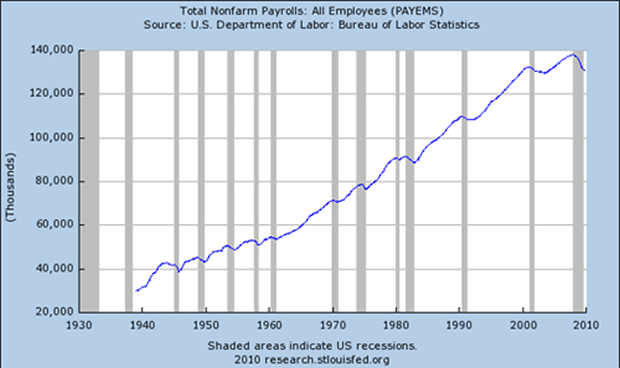Results 1 to 1 of 1
Thread Information
Users Browsing this Thread
There are currently 1 users browsing this thread. (0 members and 1 guests)
-
01-13-2010, 10:59 PM #1Senior Member


- Join Date
- May 2007
- Location
- South West Florida (Behind friendly lines but still in Occupied Territory)
- Posts
- 117,696
Unemployment: Most Important Challenge Facing the US Economy
Unemployment The Most Important Challenge Facing the U.S. Economy
Economics / US Economy Jan 13, 2010 - 09:33 AM
By: Claus_Vogt
From the start of the economic and financial crisis that began in 2007, I made it clear that this was not a garden variety recession. Instead, I said, it was the aftermath of the bursting of the largest real estate bubble the world had ever seen.
Many developments of the past three years support my thesis. Now I predict that this will not be a garden variety recovery either. We should expect some false starts in the economy and a bear market rally for stocks.
And my prediction has two important observations backing it up â¦
Observation #1 â A Secular Bear Market in Stocks
Take a look at the chart below to see what I mean by this. At Mondayâs closing price of 1,147 the S&P 500 Index was at about the same level as in the summer of 1998. So investors who bought stocks 11 years ago, havenât earned a single dime. And if you consider inflation, theyâre actually down by a whopping 25 percent!

The rollercoaster ride from 1998 until today could teach investors a lot about Wall Street and the madness of crowds, about greed and angst â and about themselves if they dared listening. For most investors, though, these lessons have been extremely expensive. And sadly, the rollercoaster hasnât stopped yet.
The stock market is still overpriced ⦠normalized price earnings ratios, as well as dividend yields and other traditional measures of valuation, are not even close to where they have been during historical long-term buying opportunities. In fact, theyâre at levels commensurate with long-term tops!
Hence, I strongly believe that the rollercoaster has not ended its blood-freezing tour. And itâs only climbing the next interim top after which another fast descent will take place â probably below the March 2009 lows.
Next, let me give you â¦
Observation #2 â A Secular Bear Market in Employment
Real prosperity goes hand in hand with employment. So even if the GDP was growing strongly, doing so without job growth wouldnât feel right and would probably be just a mirage.
Now look below at my second chart ⦠total nonfarm payrolls. As you can see something very unusual happened here. For the first time since this data series became available, all the jobs created during a prior economic expansion have been lost. Akin to the stock marketâs numbers, we are now at the same employment level as 10 years ago.

Source: Federal Reserve Bank of St. Louis
Just think about it: No new jobs in a country with a population growing 1.1 percent per year. Thatâs about 3.2 million people each year ⦠32 million over 10 years ⦠yet no new jobs!
The U-3, the official and often cited unemployment rate, is 10 percent. However, the no less official but rarely cited U-6 unemployment rate, which includes discouraged workers, marginally attached workers, and part time workers who want to work full time, comes in at 17.3 percent.
This is a frightening development, a development fitting a depression much more than a garden variety recession.
A Negative Economic Outlook
âI donât think many people grasp just how much job creation we need to climb out of the hole weâre in.âJoin our efforts to Secure America's Borders and End Illegal Immigration by Joining ALIPAC's E-Mail Alerts network (CLICK HERE)


 LinkBack URL
LinkBack URL About LinkBacks
About LinkBacks




 Reply With Quote
Reply With Quote

"YOU WILL FOOT THE BILL FOR ILLEGAL IMMIGRANTS!" GOVERNOR HOCHUL...
04-23-2024, 05:46 AM in Videos about Illegal Immigration, refugee programs, globalism, & socialism